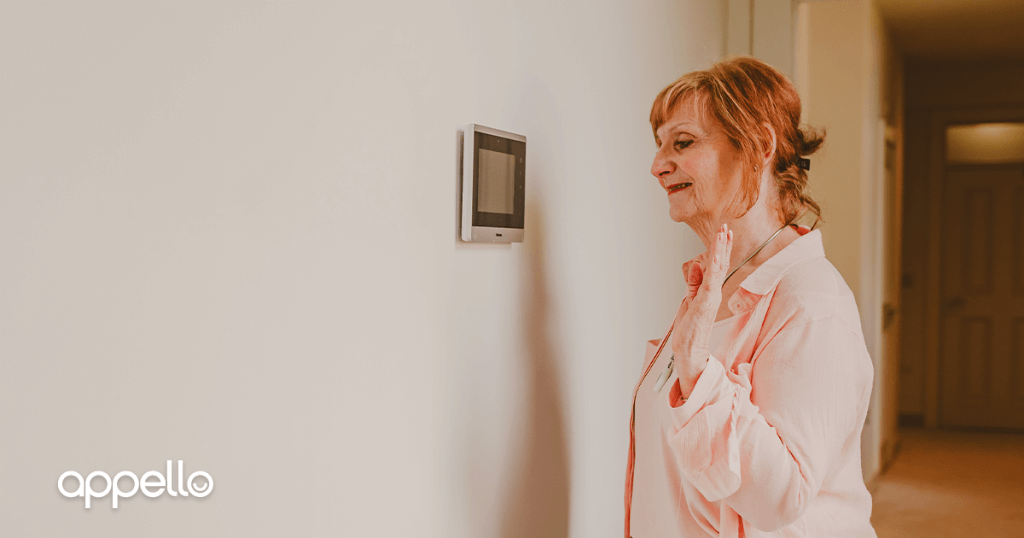Video communication was beginning to make its mark on the world pre-pandemic. Microsoft Teams was being introduced to more organisations and FaceTime was becoming a more regular way of communicating with friends and family rather than phoning them. Since the pandemic video communication has become an integral part of people’s everyday lives, especially for those in supported living.
If lockdown taught us anything, it was how important video technology was to keep in contact with loved ones. For those who were isolated and unable to visit/be visited by others, it was an extremely difficult and lonely time.
Not only were residents in housing organisations struggling, but staff were too. The inability to be able to see how a resident was, and to change to remote working in the blink of an eye forced organisations to make very quick decisions to keep everyone safe.
For those who had video communication installed already were able to reap the benefits and quickly discover the importance of it.
Why is it so important for staff?
During the pandemic video communication enabled staff to keep their distance whilst still having visual communication with their residents.
However, since everything has returned back to “normal” we have discovered that 80% of housing professionals believe that video communication between their staff and customers is becoming increasingly important to their organisation, and that they will be working towards a greater adoption of video communication1.
It has revolutionised the way staff and residents communicate and has opened up new ways for housing organisations to manage properties and keep connected with residents2. It also allows staff to maintain visual contact with residents without being overly intrusive3.
The ability to see a resident is an integral part for the staff instead of just a phone call. It enables them to assess the situation of the individual straight away. Do they need the emergency services, or do they simply just need a glass of water and a sit down? With video communication technology it offers staff the ability to see their residents when they call through, and still work from home or be in a different area of the development site, and not need to rush over.
Why is it so important for residents?
Digital telecare has been a hard aspect for elderly people to adapt to. But, during lockdown, those who had video communication were able to embrace this brand-new discovery to stay in contact with friends within the development and staff. For some, they have continued to use this digital technology today.
We found that the top three benefits of video communication for residents are:
1. Keeping in touch with loved ones.
Video chatting offered those in supported living the opportunity to speak to loved ones. Even without accounting for COVID-19, video communication with others enables individuals to stay comfortable in their own home whilst keeping in touch with family, friends, and staff.
2. Reduces loneliness and social isolation.
Loneliness and social isolation are a major factor within housing associations. According to Age UK, ‘more than 2 million people in England over the age of 75 live alone, and more than a million older people say they go for over a month without speaking to a friend, neighbour or family member.’4
Video communication combats loneliness and social isolation, by keeping individuals mental and emotional health in check.
It also acts as an alternative for those with mobility issues who struggle to move to a location to speak to people face-to-face. A resident from Housing 21 who has video technology in her room said, “I struggle to get up the stairs to see my friend and I’m hard of hearing, but now I can just video call her to check she is ok and arrange to meet up.”
Over the past few years, we have discovered, that not only were individuals utilising video technology to speak to friends, but also creating games for those in the housing development to play together, such as video bingo1.
Individuals’ feelings of loneliness and isolation can change on a day-to-day basis. With video technology readily available, it enables independence for the individual. They have greater control when/if they want to contact people3.
3. Quick communication with staff.
By being able to instantly jump on a video call with site staff, it enables them to quickly assess the resident’s situation without having to physically see them. This means that decisions can be made quickly and efficiently.
By enabling two-way interaction between resident and carer through video technology, it is mutually beneficial, as housing providers can respond to issues quickly and older individuals are comfortable knowing there is a quick and easy way to call for help when needed3.
Overall, video communication has an integral part of digital telecare within housing organisations and is the way the world is moving nowadays.
It is very important to keep residents communicating with one another, combating loneliness, and enhancing socialisation. Even if an individual feels they can’t move from their room, with video communication they can continue to have conversations with others and staff members.
It has taken telecare to another level as seeing a person helps to aid the conversation as opposed to speaking over the phone.
Appello’s Smart Living Solutions has been designed with video communication in mind. Its tablet LivingHub enables residents to contact other residents and staff through a touch screen user interface. It also enables enhanced safety and security through video door entry, allowing residents to make their own decision if an outsider can be allowed inside the building or not.
For more information visit: https://appello.co.uk/services/smart-living-solutions/
1 https://appello.co.uk/4-reasons-housing-providers-must-revise-their-telecare-needs-post-covid-19
2 https://appello.co.uk/4-enablers-to-a-better-living-experience-in-supported-housing

